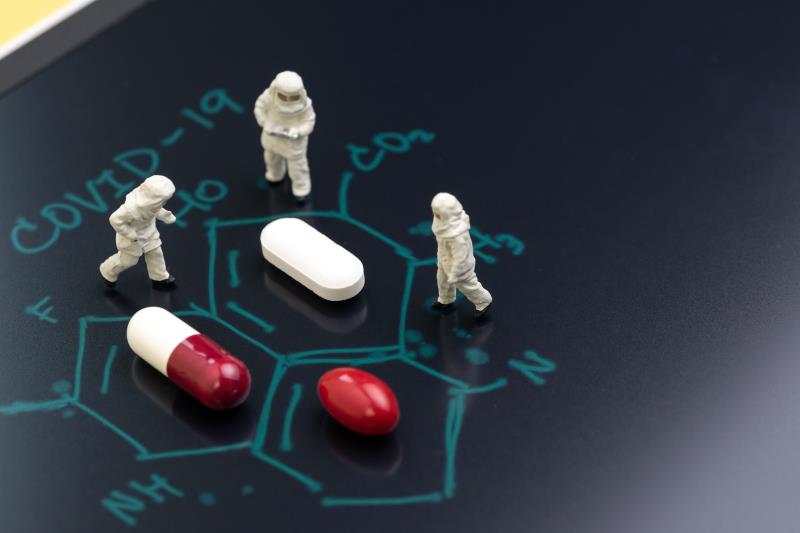
At present, there are no definitive treatments for COVID-19. Remdesivir, which is currently undergoing testing, appears to be the most promising thus far, and was recently granted emergency use authorization by the FDA* for the treatment of suspected or laboratory-confirmed COVID-19 in adults and children hospitalized with severe disease. [FDA, https://www.fda.gov/news-events/press-announcements/coronavirus-covid-19-update-fda-issues-emergency-use-authorization-potential-covid-19-treatment, accessed 6 May 2020] More than 300 clinical trials are ongoing in the search for a cure. Some of the treatments being tested were previously used, with varying levels of efficacy, in the treatment of severe acute respiratory syndrome (SARS) or Middle East respiratory syndrome (MERS).
In a recently published review in JAMA, Dr James Cutrell from the University of Texas Southwestern Medical Center, Dallas, Texas, US, and co-authors summarized some of the main drugs being tested as potential treatments for COVID-19. [JAMA 2020;doi:10.1001/jama.2020.6019]
Chloroquine and hydroxychloroquine
These two drugs have been used to treat malaria, systemic lupus erythematosus, rheumatoid arthritis, and sarcoidosis. [Lancet Infect Dis 2003;3:722-727]
High-quality evidence supporting their use for SARS or MERS is unavailable. In a small study of 36 patients with COVID-19, virological clearance with hydroxychloroquine was greater than that with standard of care (SoC; 70 percent vs 12.5 percent; p=0.001) at day 6 post-treatment. Moreover, the six patients who received azithromycin plus hydroxychloroquine had greater viral clearance than those who received hydroxychloroquine only (100 percent vs 57.1 percent; p<0.001). [Int J Antimicrob Agents 2020;doi:10.1016/j.ijantimicag.2020.105949]
Conversely, a small study of 30 patients in China showed no significant difference in virological clearance at day 7 between patients who received hydroxychloroquine plus SoC or SoC alone (86.7 percent vs 93.3 percent; p>0.05). [J Zhejiang Univ (Med Sci) 2020;doi:10.3785/j.issn.1008-9292.2020.03.03]
More research is needed before the azithromycin-hydroxychloroquine regimen is used in COVID-19, noted Cutrell and co-authors. The small sample size and the potential cardiotoxicity with combination therapy warrant consideration. Both chloroquine and hydroxychloroquine, while well tolerated, can cause rare adverse effects. Further research is also needed to identify the optimal dose for COVID-19 treatment.
Umifenovir
Approved in Russia and China for the prevention and treatment of influenza, umifenovir was associated with reduced mortality and increased likelihood of hospital discharge in patients with COVID-19 compared with non-recipients. However, the observational study design prevents conclusions from being drawn. [Clin Infect Dis 2020;doi:10.1093/cid/ciaa272] A randomized trial is underway in China to establish the efficacy of this drug. [https://clinicaltrials.gov/ct2/show/NCT04260594, accessed 21 April 2020]
Ribavirin
A review of 30 studies assessing the effect of ribavirin in SARS produced inconclusive findings, with some studies suggesting potential harm. [PLoS Med 2006;3;e343] There was also no notable effect in clinical outcomes or viral clearance with a ribavirin-interferon combination in the treatment of MERS. [Clin Infect Dis 2020;70:1837-1844]
“The inconclusive efficacy data with ribavirin for other [novel coronaviruses] and its substantial toxicity [eg, haemolytic anaemia, transaminase elevations] suggest that it has limited value for treatment of COVID-19. If used, combination therapy likely provides the best chance for clinical efficacy,” said Cutrell and co-authors.
Interferon-α and -β
Published studies looking at the combination of interferons with ribavirin or lopinavir/ritonavir for SARS and MERS suggest that the effects may be affected by timing of treatment administration. [Expert Opin Drug Discov 2019;14:397-412]
Due to conflicting evidence and the lack of clinical trials investigating the efficacy of this group of drugs, interferon-α and -β are not currently recommended for COVID-19. However, α-interferon is listed as a potential therapeutic option in China. [National Health Commission and State Administration of Traditional Chinese Medicine, https://www.chinalawtranslate.com/wp-content/uploads/2020/03/Who-translation.pdf, accessed 21 April 2020]
“[I]t remains to be seen whether [other immunomodulatory agents] confer protection for patients already taking them for other indications,” said Cutrell and co-authors.
Favipravir
A post hoc analysis of a 240-patient randomized study showed that favipravir induced greater clinical recovery at 7 days compared with umifenovir in patients with moderate COVID-19 infections (71.4 percent vs 55.9 percent; p=0.019). However, there was no between-group difference observed for severe infections. [medRxiv 2020;doi:10.1101/2020.03.17.20037432]
Further investigation is necessary to determine the efficacy of favipravir for COVID-19, said Cutrell and co-authors.
Nitazoxanide
Having shown in vitro activity against MERS and SARS-CoV-2, the broad-spectrum antiviral and antiparasitic drug nitazoxanide is being investigated as a potential treatment for COVID-19. [COVID-19 Science Report, https://sph.nus.edu.sg/wp-content/uploads/2020/04/COVID-19-Science-Report-Therapeutics-20-Apr.pdf, accessed 21 April 2020]
Lopinavir-ritonavir
A randomized trial of 199 adults with SARS-CoV-2 infection showed that combining lopinavir-ritonavir with SoC did not speed up clinical improvement compared with SoC alone (median 16 days in each group). The mortality rate was numerically but not significantly lower with lopinavir-ritonavir vs SoC (16.7 percent vs 25.0 percent), while intensive care stay was shorter with lopinavir-ritonavir (median 6 vs 11 days). [N Engl J Med 2020;doi:10.1056/NEJMoa2001282]
Despite these findings, it remains to be seen if the timing of lopinavir-ritonavir administration could affect certain outcomes of COVID-19, said the researchers. Future studies should investigate the effect of combining lopinavir-ritonavir with other antiviral agents.
Oseltamivir
A study from China showed that prior to identification of SARS-CoV-2 as the cause of COVID-19, most patients in the study received empirical oseltamivir due to the mistaken assumption that their symptoms were due to influenza. [JAMA 2020;323:1061-1069] However, it has been established that upon exclusion of influenza, oseltamivir has no role in COVID-19 treatment.
Current advice
Both the CDC and WHO** advise against corticosteroid use unless required for other indications such as exacerbation of chronic obstructive pulmonary disease or septic shock. [CDC, https://www.cdc.gov/coronavirus/2019-ncov/hcp/clinical-guidance-management-patients.html; WHO, https://www.who.int/publications-detail/clinical-management-of-severe-acute-respiratory-infection-when-novel-coronavirus-(ncov)-infection-is-suspected, accessed 21 April 2020]
There are also limitations pertaining to the use of repurposed medications for COVID-19, such as the potential of toxicity outweighing the benefits, said Cutrell and co-authors.
“[T]he [current] cornerstone of care for patients with COVID-19 remains supportive care, ranging from symptomatic outpatient management to full intensive care support,” they said.